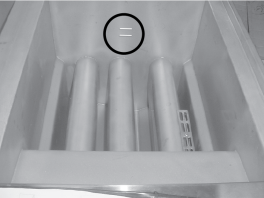Filling and Adding Oil

|
Follow the instructions below to avoid oil overflowing the vat, which could result in serious burns, personal injury, fire, and/or property damage. |
-
To protect the oil when the fryer is not in immediate use, the fryer should be turned off.
-
Frying breaded products requires filtering to keep the oil clean. Oil should be skimmed frequently throughout the day and filtered thoroughly once a day.
-
Dispose oil if display shows “CHANGE OIL SOON” or if oil shows signs of excessive foaming or smoking.
-
Maintain the oil at the proper cooking level. Check and fill the reserve oil tank throughout the day.
-
Do not overload the baskets with product, or place product with extreme moisture content into baskets.

|
The oil level must always be above the heating elements and at the proper oil level indicator on the rear of the vat. Failure to follow these instructions may result in fire, severe burns, and/or damage to the fryer. |

|
To avoid severe burns when pouring hot oil into vat, wear personal protective equipment (PPE) and take care to avoid splashing. |

|
To avoid personal injury and fire, ensure that oil completely covers heating elements |
Do not bypass the Melt Cycle. The type of oil being used in the fryer determines the amount of heat applied during the Melt Cycle. If the controls are set to the Solid setting, less heat is applied to the solid oil than if the controls were set to Liquid. Too much heat applied to solid oil causes much smoking, and could cause a fire. Match this setting to the type of oil being used at the time. When using new solid oil, it is recommended to melt the solid oil on an outside source before placing oil in the vat.

|
Use high quality liquid frying oil in the open fryer. Some low grade oils have a high moisture content which causes foaming and boiling over. |
Oil Capacity
130 lbs (59 kg) per full vat




